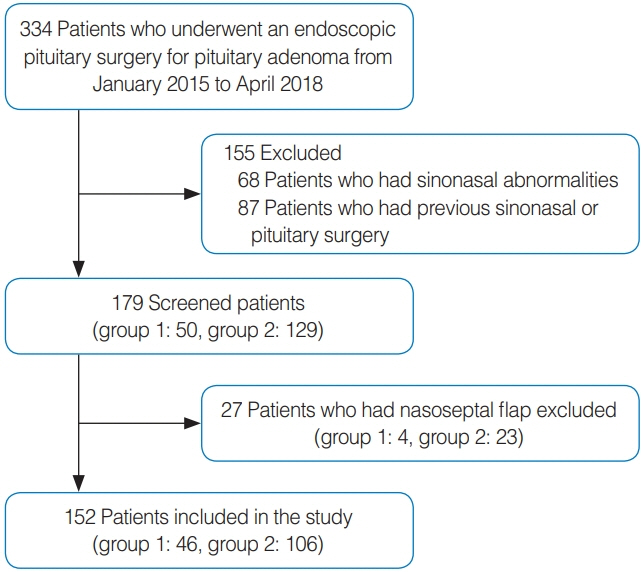Clin Exp Otorhinolaryngol.
2020 Aug;13(3):261-267. 10.21053/ceo.2019.01466.
A Comparison of Olfactory and Sinonasal Outcomes in Endoscopic Pituitary Surgery Performed by a Single Neurosurgeon or a Collaborative Team of Surgeons
- Affiliations
-
- 1Department of Otorhinolaryngology-Head and Neck SurgeryNeurosurgery, Samsung Medical Center, Sungkyunkwan University School of Medicine, Seoul, Korea
- 2Department of Neurosurgery, Samsung Medical Center, Sungkyunkwan University School of Medicine, Seoul, Korea
- 3Department of Otorhinolaryngology-Head and Neck Surgery, Samsung Changwon Hospital, Sungkyunkwan University School of Medicine, Changwon, Korea
- KMID: 2504921
- DOI: http://doi.org/10.21053/ceo.2019.01466
Abstract
Objectives
. Endoscopic pituitary surgery usually requires a collaboration between neurosurgeons and ENT surgeons to achieve optimal outcomes. However, neurosurgeons occasionally perform these procedures alone without an ENT surgeon. In this study, postoperative sinonasal quality of life and olfactory function were compared in patients who underwent endoscopic pituitary surgery performed by a single neurosurgeon or by a collaborative team of a neurosurgeon and an ENT surgeon.
Materials and Methods
. A retrospective review of prospectively collected data was performed. Patients who underwent endoscopic pituitary surgery for pituitary adenoma from January 2015 to April 2018 were included. The study patients were divided into two groups; patients in group 1 underwent surgery performed by a single neurosurgeon, while patients in group 2 received surgery performed by a collaborative team of surgeons. Olfaction was assessed using a subjective Likert scale, the Cross-Cultural Smell Identification Test (CC-SIT), and the butanol threshold test (BTT). In addition, patients answered the Sino-nasal Outcome Test (SNOT-22) questionnaire regarding sinonasal quality of life before and 3 months after surgery.
Results
. This study included 152 patients (46 patients in group 1 and 106 patients in group 2). Significant differences were not observed between the two groups regarding age, sex, tumor size, or operation time. Although subjective olfaction was not significantly different before and after surgery, group 2 showed significantly better objective olfactory function based on the CC-SIT (8.44±3.00 vs. 9.84±1.40; P=0.012) and BTT (4.67±0.84 vs. 5.02±0.33; P=0.022) scores at 3 months after surgery. The SNOT-22 scores were not statistically significantly different between the two groups (P>0.05).
Conclusion
. In the present study, better olfactory outcomes were observed in patients who underwent surgery performed by a collaborative team of a neurosurgeon and an ENT surgeon. This result shows the need for collaboration between neurosurgeons and ENT surgeons in endoscopic pituitary surgery.
Figure
Reference
-
1. Jho HD, Carrau RL. Endoscopic endonasal transsphenoidal surgery: experience with 50 patients. J Neurosurg. 1997; Jul. 87(1):44–51.
Article2. Stammberger H. Endoscopic endonasal surgery: concepts in treatment of recurring rhinosinusitis. Part II. Surgical technique. Otolaryngol Head Neck Surg. 1986; 94(2):147–56.3. Jane JA Jr, Han J, Prevedello DM, Jagannathan J, Dumont AS, Laws ER Jr. Perspectives on endoscopic transsphenoidal surgery. Neurosurg Focus. 2005; Dec. 19(6):1–10.
Article4. D’Haens J, Van Rompaey K, Stadnik T, Haentjens P, Poppe K, Velkeniers B. Fully endoscopic transsphenoidal surgery for functioning pituitary adenomas: a retrospective comparison with traditional transsphenoidal microsurgery in the same institution. Surg Neurol. 2009; Oct. 72(4):336–40.5. Singh A, Wessell AP, Anand VK, Schwartz TH. Surgical anatomy and physiology for the skull base surgeon. Oper Tech Otolayngol Head Neck Surg. 2011; Sep. 22(3):184–93.
Article6. van Lindert EJ, Ingels K, Mylanus E, Grotenhuis JA. Variations of endonasal anatomy: relevance for the endoscopic endonasal transsphenoidal approach. Acta Neurochir (Wien). 2010; Jun. 152(6):1015–20.
Article7. Pledger CL, Elzoghby MA, Oldfield EH, Payne SC, Jane JA Jr. Prospective comparison of sinonasal outcomes after microscopic sublabial or endoscopic endonasal transsphenoidal surgery for nonfunctioning pituitary adenomas. J Neurosurg. 2016; Aug. 125(2):323–33.
Article8. Little AS, Kelly DF, Milligan J, Griffiths C, Prevedello DM, Carrau RL, et al. Comparison of sinonasal quality of life and health status in patients undergoing microscopic and endoscopic transsphenoidal surgery for pituitary lesions: a prospective cohort study. J Neurosurg. 2015; Sep. 123(3):799–807.
Article9. Snyderman CH, Wang EW, Fernandez-Miranda JC, Gardner PA. The making of a skull base team and the value of multidisciplinary approach in the management of sinonasal and ventral skull base malignancies. Otolaryngol Clin North Am. 2017; Apr. 50(2):457–65.
Article10. Ismail M, Abdelaziz AA, Darwish M. A comparison between collaborative and single surgeon approach in endoscopic endonasal surgery to sphenoid sinus. Eur Arch Otorhinolaryngol. 2019; Apr. 276(4):1095–100.
Article11. Sowerby LJ, Gross M, Broad R, Wright ED. Olfactory and sinonasal outcomes in endoscopic transsphenoidal skull-base surgery. Int Forum Allergy Rhinol. 2013; Mar. 3(3):217–20.
Article12. Greig SR, Cooper TJ, Sommer DD, Nair S, Wright ED. Objective sinonasal functional outcomes in endoscopic anterior skull-base surgery: an evidence-based review with recommendations. Int Forum Allergy Rhinol. 2016; Oct. 6(10):1040–6.
Article13. Yin LX, Low CM, Puccinelli CL, O’Brien EK, Stokken JK, Van Abel KM, et al. Olfactory outcomes after endoscopic skull base surgery: asystematic review and meta-analysis. Laryngoscope. 2019; Sep. 129(9):1998–2007.14. Puccinelli CL, Yin LX, O’Brien EK, Van Gompel JJ, Choby GW, Van Abel KM, et al. Long-term olfaction outcomes in transnasal endoscopic skull-base surgery: a prospective cohort study comparing electrocautery and cold knife upper septal limb incision techniques. Int Forum Allergy Rhinol. 2019; May. 9(5):493–500.
Article15. Gao Y, Zhong C, Wang Y, Xu S, Guo Y, Dai C, et al. Endoscopic versus microscopic transsphenoidal pituitary adenoma surgery: a metaanalysis. World J Surg Oncol. 2014; Apr. 12:94.
Article16. DeKlotz TR, Chia SH, Lu W, Makambi KH, Aulisi E, Deeb Z. Meta-analysis of endoscopic versus sublabial pituitary surgery. Laryngoscope. 2012; Mar. 122(3):511–8.
Article17. Casler JD, Doolittle AM, Mair EA. Endoscopic surgery of the anterior skull base. Laryngoscope. 2005; Jan. 115(1):16–24.
Article18. Soudry E, Psaltis AJ, Lee KH, Vaezafshar R, Nayak JV, Hwang PH. Complications associated with the pedicled nasoseptal flap for skull base reconstruction. Laryngoscope. 2015; Jan. 125(1):80–5.
Article
- Full Text Links
- Actions
-
Cited
- CITED
-
- Close
- Share
- Similar articles
-
- Surgical outcomes of endoscopic versus open resection for the management of sinonasal malignancies
- The Predictive Factors of Olfactory Changes after Endoscopic Sinus Surgery
- Advances in Pituitary Surgery
- Clinical Value of Olfactory Function Test Following Functional Endoscopic Sinus Surgery
- Endoscopic Resection of Sinonasal Malignant Tumors


